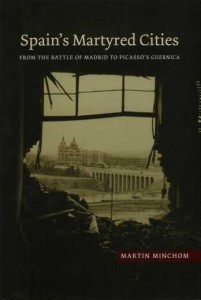Book Review: Spain’s Martyred Cities: From the Battle of Madrid to Picasso’s Guernica
 Minchom, Martin. Spain’s Martyred Cities: From the Battle of Madrid to Picasso’s Guernica: Including the Reconstructed Text of Louis Delaprée’s The Martyrdom of Madrid. Sussex Academic Press, 2016.
Minchom, Martin. Spain’s Martyred Cities: From the Battle of Madrid to Picasso’s Guernica: Including the Reconstructed Text of Louis Delaprée’s The Martyrdom of Madrid. Sussex Academic Press, 2016.
We are often unaware of the ways in which journalism has shaped and influenced our conception of a historical conflict. Martin Minchom’s Spain’s Martyred Cities addresses this question through a history of French journalist Louis Delaprée’s work during the Spanish Civil War. While journalism and photojournalism have long been subjects of interest in both popular and academic Spanish Civil War historiography, this is the first monograph that addresses the role that Delaprée played in shaping many of the prominent narratives of the conflict—influencing not just Virginia Woolf, Pablo Picasso, and André Malraux, but most of the prominent stories about the war that are sustained to this day.
Louis Delaprée, a moderate, politically independent French journalist, covered both Nationalist and Republican territories during 1936 for the commercial Sunday night paper Paris-Soir. His experiences with the Nationalist terror bombings in Madrid during November 1936 marked his transformation into a kind of prophetic voice of dissent. His writing gradually became personal, dramatic and urgent as he sought to condemn the atrocities he witnessed, despite the relative indifference of Paris-Soir editors to the events unfolding in Spain. Later, Delaprée’s mysterious and controversial death in an airplane crash converted the writer into a legend. It also provoked a series of controversies about editorial deception, ultimately resulting in the publication of the seminal pro-Republican pamphlet The Martyrdom of Madrid, which would go on to influence many leading writers and artists of his day.
Minchom’s Spain’s Martyred Cities is a self-proclaimed “hybrid text” that includes a history of Delaprée’s life, work, and influence; a critical discussion of the influence of journalism on the primary narratives of the Spanish Civil War; and a lengthy annotated text written by Delaprée himself. Minchom dedicates Chapters 3 and 4 to the Battle for Madrid and the bombing of Madrid respectively, and to some of the biases and tropes adopted in international reporting. He attributes some of the emphasis placed on the heroism of International Brigades in the battle for Madrid to a publicity campaign organized by the press-censors Arturo Barea, Gustav Regler and Ilsa Kulcsar, and to the fact that non-Spanish speaking international reporters were finally able to communicate with participants in their mother tongues. Chapter 4 shows how international reporting turned the Madrid bombings of November into an international media event. They also marked a turning point in Louis Delaprée’s sense of vocation and led to his eventual falling out with the Paris-Soir.
The third and final section of the book explains how Louis Delaprée, after his death, became a legend and a symbol of ethical and honest journalism among many French progressives. Minchom highlights the link between the “Delaprée affair” and Picasso’s conversion to explicitly political art. He argues that Guernica not merely represents Picasso’s reaction to the bombardment of the Basque city of that name, but also those of Madrid and Durango—events whose narratives were shaped by Delaprée’s writing and the subsequent press controversy.
The book’s hybridity is its greatest strength and weakness. While it embarks on important questions, the text meanders, dithering in tedious historical debates that don’t always seem centrally relevant to the principal aims of the book. The book also lacks a conclusion to solidify its central claims that Delaprée, and French journalism in general, played a central role in the construction of some of the most salient narratives of the war.
By and large, however, Spain’s Martyred Cities is a thought-provoking, thorough, original, and important work about the complex relationships between journalists, editors, editorial conditions, and war. It also is relevant to our times. In an era of tension among the press, civilians, and political powers, Spain’s Martyred Cities shows that debates about journalistic integrity are not new and that journalism does indeed shape our understanding of conflict, perhaps to a greater degree than we may realize.
Katherine O. Stafford is an Assistant Professor of Spanish at Lafayette College. She is the author of Narrating War in Peace: The Spanish Civil War in the Transition and Today (Palgrave Macmillan, 2015) and has worked recently on the image of perpetrators in contemporary Spanish history and memory.












